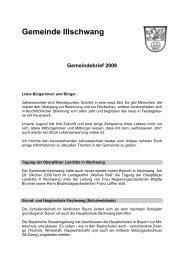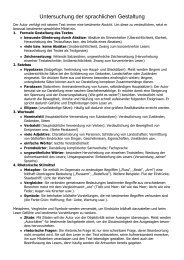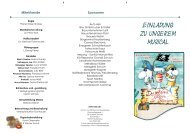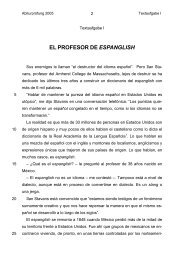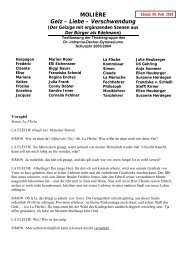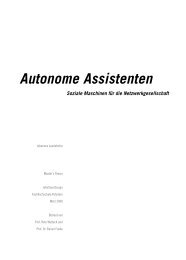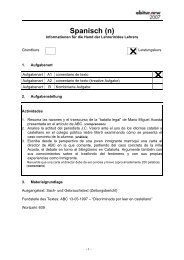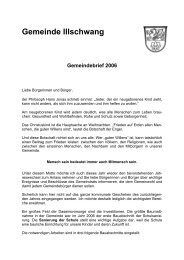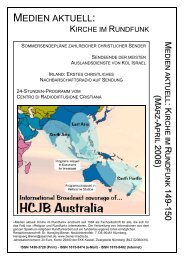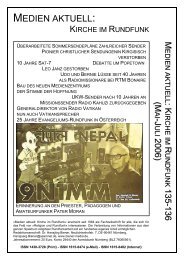Enhanced T cell responsiveness to citrulline-containing ... - Asamnet
Enhanced T cell responsiveness to citrulline-containing ... - Asamnet
Enhanced T cell responsiveness to citrulline-containing ... - Asamnet
You also want an ePaper? Increase the reach of your titles
YUMPU automatically turns print PDFs into web optimized ePapers that Google loves.
Multiple Sclerosis (2000) 6, 220±225<br />
ã 2000 Macmillan Publishers Ltd All rights reserved 1352 ± 4585/00 $15.00<br />
www.nature.com/ms<br />
<strong>Enhanced</strong> T <strong>cell</strong> <strong>responsiveness</strong> <strong>to</strong> <strong>citrulline</strong>-<strong>containing</strong> myelin basic protein<br />
in multiple sclerosis patients<br />
Laura R Tranquill 1 , Ligong Cao 2,3 , Nicholas C Ling 5 , Hubert Kalbacher 6 , Roland M Martin 1 and<br />
John N Whitaker* ,2,3,4<br />
1 Neuroimmunology Branch, NINDS, NIH, Bethesda, Maryland, MD 20892-1400 USA; 2 Department of Neurology,<br />
University of Alabama at Birmingham, Birmingham, Alabama, AL 35233-7340 USA; 3 Center for Neuroimmunology of<br />
the University of Alabama at Birmingham, Birmingham, Alabama, AL 35294 USA; 4 Neurology and Research Services of<br />
the Birmingham Veterans Medical Center, Birmingham, Alabama, AL 35233 USA; 5 Neurocrine Biosciences, San Diego,<br />
California, CA 92121 USA; 6 Physiologisch-Chemisches Institut der UniversitaÈt, TuÈ bingen University Medical School,<br />
72076 TuÈ bingen, Germany<br />
Myelin basic protein (MBP), a candidate au<strong>to</strong>antigen in multiple sclerosis (MS), exists in different isoforms and charge isomers generated by<br />
differential splicing of exons and by a combination of posttranslational modi®cations, respectively. These various isoforms and charge isomers of<br />
MBP vary in abundance and most likely serve different functions during myelinogenesis and remyelination. The least cationic among the charge<br />
isomers of MBP is citrullinated and is referred <strong>to</strong> as MBP-C8. MBP-C8 is relatively increased in the population of MBP isomers in more<br />
developmentally immature myelin and in MS brain tissue. In a previous study, we found that MBP-C8-reactive T <strong>cell</strong>s could be detected in CD4+ T<br />
<strong>cell</strong> lines (TCL) generated with MBP from both MS patients and normal controls. Here, we examined the frequency and peptide speci®city of MBP-<br />
C8-speci®c TCL generated with MBP-C8 in MS patients and controls. Ten subjects grouped in ®ve sets, each an MS patient and a control, were<br />
studied. In all cases, the MS patient had either a higher overall number of MBP-C8-responding lines, responded with greater sensitivity <strong>to</strong> the MBP-<br />
C8 antigen or both. Few lines responded <strong>to</strong> the MBP-C8 peptides but, if they did, they appeared <strong>to</strong> be speci®c <strong>to</strong> the carboxyl-half of the MBP-C8<br />
molecule. Given the large amounts of citrullinated MBP in MS brain tissue, a preferential T <strong>cell</strong> response <strong>to</strong> MBP-C8 may be involved in the<br />
induction and perpetuation of this disease.<br />
Multiple Sclerosis (2000) 6, 220±225<br />
Keywords: multiple sclerosis; MBP; <strong>citrulline</strong>; T <strong>cell</strong>s; human; isomer<br />
Introduction<br />
MS, the most frequent in¯amma<strong>to</strong>ry demyelinating<br />
CNS disease in humans, is considered a T <strong>cell</strong>mediated<br />
au<strong>to</strong>immune disease. 1 Its pathogenesis is<br />
most likely multifac<strong>to</strong>rial and involves both genetic<br />
predisposition and precipitating environmental fac<strong>to</strong>rs.<br />
MBP, which constitutes approximately 30% of the<br />
<strong>to</strong>tal CNS myelin protein, has been studied extensively<br />
as a possible au<strong>to</strong>antigen in MS. 1 There are four major<br />
isoforms of human MBP. The 18.5 kDa isoform is the<br />
most abundant in humans. 2 In addition <strong>to</strong> size<br />
heterogeneity, the 18.5 kDa isoform of MBP has at<br />
least six charge isomers which can be resolved by<br />
cation- or anion exchange chroma<strong>to</strong>graphy at alkaline<br />
pH 3 or according <strong>to</strong> net positive charge respectively. 4,5<br />
These charge isomers are designated C1, the most<br />
cationic, C2 ± 5 which are progressively less cationic<br />
by one charge, and C8, the least cationic and the most<br />
modi®ed. 5 Posttranslational modi®cations of the<br />
charge isomers include phosphorylation, deamidation,<br />
C-terminal arginine loss, and the presence of <strong>citrulline</strong><br />
*Correspondence: JN Whitaker, Department of Neurology,<br />
University of Alabama at Birmingham, 619 19th Street South,<br />
JT 1205, Birmingham, Alabama, AL 35249-7340, USA<br />
Received 12 January 2000; accepted 4 April 2000<br />
substituted for arginine at de®ned sites in the NH 2- and<br />
COOH-terminal portions of the molecule. 5<br />
In the charge isomer, MBP-C8, six arginines are<br />
replaced by <strong>citrulline</strong> resulting in the loss of six<br />
positive charges. In the human MBP molecule of 170<br />
amino acid residues, the arginine <strong>to</strong> <strong>citrulline</strong> change<br />
occurs on residues 25, 31, 122, 130, 159 and 170. 4 The<br />
removal of positive charges alters the interaction of<br />
MBP with membrane-embedded acidic lipid moieties. 6<br />
S<strong>to</strong>ner 7 proposed a model that suggested that certain<br />
arginine residues of the MBP molecule stabilize its<br />
loop structure by ionic interactions with carboxyl and<br />
phosphoryl groups, and that by substitution of<br />
<strong>citrulline</strong>s in MBP-C8, a destabilization of the loop<br />
structure and possibly a conformational change in the<br />
MBP molecule may result. In a study of the formation<br />
of myelin crystalline multilayers, Moscarello 8 observed<br />
that the denser and less compact myelin showed an<br />
increased amount of MBP-C8 and a relative de®ciency<br />
of MBP-C1. These authors suggest that the more MBP-<br />
C1 in myelin, the more compact the myelin layers.<br />
Moscarello 9 has also determined that the myelin<br />
obtained from MS patients appears <strong>to</strong> be in a<br />
developmentally less mature stage with the percentage<br />
of MBP-C8 increased in MS white matter. This MBP-<br />
C8-rich, developmentally immature myelin may be
more susceptible <strong>to</strong> degradation since it is less<br />
compact than mature myelin and cannot form as<br />
highly a structured myelin sheath as MBP-C1. The<br />
resulting myelin instability may promote myelin<br />
breakdown and thus either initiate and/or perpetuate<br />
au<strong>to</strong>immune T <strong>cell</strong> responses against CNS myelin. 9 In<br />
fact, citrullination of MBP increases the speed of its<br />
degradation by cathepsin D. 10 Alternatively, as the<br />
number of attacks increase, relatively more MBP-C8<br />
may be formed; MBP-C8 becomes available <strong>to</strong> the<br />
immune system and its increased incidence may<br />
perpetuate disease.<br />
The role of MBP is still controversial in MS since<br />
most of the evidence in humans is indirect. CD4+<br />
MBP-speci®c T <strong>cell</strong>s are often cy<strong>to</strong><strong>to</strong>xic, 11,12 directed<br />
against immunodominant regions of MBP which are<br />
also encephali<strong>to</strong>genic in rodent strains, 13 ± 15 often<br />
express a Th1-type phenotype, 16 and are frequently<br />
restricted by MS-associated HLA-DR molecules. 13,14<br />
Currently, the role of MBP or also other myelin or<br />
glial components such as proteolipid protein (PLP),<br />
myelin oligodendrocyte glycoprotein (MOG), or aB<br />
crystalline, <strong>to</strong> name only a few, are being evaluated. 1<br />
In addition, other size isoforms and charge isomers of<br />
MBP have also been examined both in EAE 17,18 and in<br />
MS patients. 19,20 Due <strong>to</strong> the above reasoning, we have<br />
been interested in MBP-C8 as a potential encephali<strong>to</strong>gen<br />
17 and target antigen in MS. 21 Our data have<br />
documented so far that MBP-C8 is indeed able <strong>to</strong><br />
induce EAE, 17 and a T <strong>cell</strong> response <strong>to</strong> MBP-C8 is<br />
readily demonstrable in MS patients. 19 The current<br />
study extends these previous observations by focusing<br />
on the frequencies of MBP-C8-reactive T <strong>cell</strong>s in MS<br />
versus controls, and also initiates the attempts <strong>to</strong><br />
characterize the speci®city of the C8-reactive lines<br />
using a panel of citrullinated MBP peptides.<br />
Material and methods<br />
Patients<br />
Five male patients with de®nite MS, four with primary<br />
progressive (PP), one with relapsing-remitting (RR)<br />
MS, were investigated at the Neuroimmunology<br />
Branch, NINDS, National Institutes of Health (NIH).<br />
We attempted <strong>to</strong> examine patients with progressive<br />
Table 1 Summary of clinical features and HLA haplotypes of MS patients<br />
Sex<br />
Age<br />
MS type<br />
Disease<br />
Suration<br />
Disability e<br />
HLA-DR<br />
disease since an accumulation of MBP-C8 in MS<br />
brains with increasing disease duration had been<br />
reported. 9 The research project was reviewed and<br />
approved by the Institute Clinical Research Subpanel,<br />
and informed consent was obtained from each patient.<br />
MS patient demographics and clinical data are<br />
summarized in Table 1. No patient was or had been<br />
on immunomodula<strong>to</strong>ry or immune suppressive treatment<br />
at any time or had received glucocorticoids<br />
within 90 days.<br />
Cells<br />
Peripheral blood lymphocytes (PBL) were isolated<br />
from leukapheresis samples by Lymphocyte Separation<br />
Medium (Organon Teknika, Durham, NC, USA).<br />
After isolation, <strong>cell</strong>s were cryopreserved in RPMI 1640<br />
(Whittaker Bioproducts, Walkersville, MD, USA)<br />
supplemented with 20% fetal calf serum (GIBCO,<br />
Grand Island, NY, USA) or 20% human serum, and<br />
10% dimethylsulfoxide (Sigma, St. Louis, MO, USA)<br />
and s<strong>to</strong>red in liquid nitrogen until use. HLA typing for<br />
HLA-A, -B, -Cw, -DR, and -DQ was performed kindly<br />
by T Simonis, Department of Transfusion Medicine,<br />
NIH, Bethesda, MD, USA. HLA-DR and -DQ types are<br />
summarized in Table 1.<br />
Antigens<br />
MBP-C1 was prepared from postmortem human<br />
brain. 22,23 MBP-C8 was prepared from the pH3 extract<br />
of human brain by a combination of cation-exchange<br />
chromo<strong>to</strong>graphy and high-pressure liquid chroma<strong>to</strong>graphy<br />
(HPLC) as described. 4 Citrulline-<strong>containing</strong><br />
MBP-peptides were made for regions <strong>containing</strong> <strong>citrulline</strong><br />
modi®cations. 19 Using a numbering system based<br />
on 170 residues in MBP, the following three <strong>citrulline</strong><strong>containing</strong><br />
peptides were synthesized as described: 24<br />
18 ± 38 (ASTMDHACitHGFLPCitHRDTGIL) with <strong>citrulline</strong><br />
substitutions at positions 25 and 31, 115 ± 131<br />
(SWGAEGQCitPGFGYGGCitA) with <strong>citrulline</strong> substitutions<br />
at positions 122 and 130, and 151 ± 170<br />
(SKIFKLGGCitDSRSGSPMARR) with a <strong>citrulline</strong> substitution<br />
at position 159. No posttranslational modi®cations<br />
other than citrullination were included in<br />
the peptide sequences. All peptides were puri®ed by<br />
using HPLC <strong>to</strong> a purity 495%.<br />
MS1 MS2 MS3 MS4 MS5<br />
M<br />
43<br />
PP a<br />
SC c :1980<br />
DX d :1988<br />
8.0<br />
B1*0101<br />
B1*0405<br />
M<br />
59<br />
PP<br />
SX:1965<br />
DX:1974<br />
8.5<br />
B1*0402<br />
B1*1502<br />
T <strong>cell</strong> response <strong>to</strong> MBP-C8 in MS<br />
LR Tranquill et al<br />
M<br />
49<br />
RR b<br />
SX:1981<br />
DX:1988<br />
3.0<br />
2(15),4<br />
M<br />
67<br />
PP<br />
SX:1959<br />
DX:1965<br />
7.0<br />
2<br />
M<br />
49<br />
PP<br />
SX:1979<br />
DX:1984<br />
7.5<br />
2(15),4<br />
a b c d e<br />
PP=primary progressive. RR=relapsing remitting. SX=onset of symp<strong>to</strong>ms. DX=year of diagnosis. Disability expressed on<br />
Expanded Disability Status Scale (Kurtzke, 1983)<br />
221<br />
Multiple Sclerosis
222<br />
Multiple Sclerosis<br />
Generation of MBP-C8-speci®c T <strong>cell</strong> lines (TCL)<br />
PBL were seeded in complete media (Iscove's modi®ed<br />
Dulbecco's medium with 2 mM L-glutamine, 50 mg/ml<br />
gentamicin, 100 U/ml penicillin, and 100 mg/ml strep<strong>to</strong>mycin-Whittaker<br />
Bioproducts, Gaithersburg, MD,<br />
USA) at 2610 5 <strong>cell</strong>s/well in<strong>to</strong> 96-well, U-bot<strong>to</strong>m<br />
microtiter plates (Nunc, Denmark) at 200 ml per well<br />
and stimulated with 5 mg/ml of MBP-C8. Seven <strong>to</strong> 10<br />
days later, IL-2 (Lymphocult-T HP, Biotest, Germany;<br />
®nal concentration, 10 U/ml) was added. After another<br />
7 <strong>to</strong> 10 days, <strong>cell</strong>s were washed once within the plate<br />
<strong>to</strong> remove lymphokines and resuspended in 200 ml of<br />
complete medium. Fifty ml of the <strong>cell</strong> suspension were<br />
transferred in<strong>to</strong> three adjacent wells of a separate 96well,<br />
U-bot<strong>to</strong>m microtiter plate, and 150 ml of complete<br />
medium <strong>containing</strong> 1610 5 au<strong>to</strong>logous, irradiated<br />
(3000 rad) PBL added. One well was stimulated with<br />
5 mg/ml MBP-C8 and the other with 5 mg/ml MBP-C1.<br />
Seventy-two hours later, 1 mCi of [ 3 H]thymidine<br />
(Amersham, Arling<strong>to</strong>n Heights, IL, USA) was added<br />
for 4 h before [ 3 H]thymidine incorporation was measured<br />
in a scintillation counter (Betaplate, Pharmacia,<br />
Gaithersburg, MD, USA). The remaining wells in the<br />
original plates were restimulated with 1610 5 au<strong>to</strong>logous,<br />
irradiated PBL and MBP-C8 at 5 mg/ml at the<br />
same time the proliferation was analyzed. Wells with a<br />
stimulation index (SI=c.p.m. of wells with antigen/<br />
c.p.m. of wells without antigen) 42 and 41000 c.p.m.<br />
in the proliferative assay were transferred in<strong>to</strong> 24-well<br />
plates (Costar, Cambridge, MA, USA), restimulated as<br />
described above, and characterized for speci®city by<br />
proliferative assay.<br />
Proliferative assays<br />
Proliferative assays were performed as described. 11<br />
Brie¯y, 2610 4 line <strong>cell</strong>s were incubated for 72 h with<br />
5±10610 4 irradiated (3000 rad), au<strong>to</strong>logous PBL as<br />
antigen-presenting <strong>cell</strong>s (APC) and two concentrations<br />
(10 and 20 mg/ml ®nal concentration) of antigens or<br />
peptides. One mCi of [ 3 H]thymidine (Amersham) was<br />
added for another 4 h. Thymidine incorporation was<br />
measured in a scintillation counter (Betaplate, Pharmacia,<br />
Gaithersburg, MD, USA). Responses were<br />
scored positive at an SI42 and 41000 c.p.m.<br />
Results<br />
CD4+ TCL were generated with MBP-C8 by seeding in<br />
parallel PBL from ®ve MS patients and ®ve normal<br />
controls in a standard split well limiting dilution<br />
assay. During the split-well screening, which is<br />
routinely performed between 14 and 17 days after<br />
seeding, colonies are tested against MBP-C1, MBP-C8<br />
and no antigen. Responses were scored positive at an<br />
SI42 and 41000 c.p.m. The TCL were grouped in<br />
three categories based on their proliferative responses<br />
<strong>to</strong> the antigens: MBP-C8-responsive only, MBP-C1responsive<br />
only as well as MBP-C8/MBP-C1-responsive.<br />
As shown in Table 2, patient/control set number<br />
1 showed the most impressive differences in the C8<br />
Table 2 Summary of frequency and speci®city of MBP-C8 responsive T <strong>cell</strong> lines from MS patients and normals<br />
Antigen<br />
MBP-C1/MBP-C8<br />
C1 C8 MBP-C8 only MBP-C1 only<br />
Sets Patients Normal SI M # M # M # M #<br />
1 MS1<br />
2 MS2<br />
3 MS3<br />
4 MS4<br />
5 MS5<br />
ND1<br />
ND2<br />
ND3<br />
ND4<br />
ND5<br />
T <strong>cell</strong> response <strong>to</strong> MBP-C8 in MS<br />
LR Tranquill et al<br />
53<br />
55<br />
53<br />
55<br />
53<br />
55<br />
53<br />
55<br />
53<br />
55<br />
53<br />
55<br />
53<br />
55<br />
53<br />
55<br />
53<br />
55<br />
53<br />
55<br />
6.0<br />
7.4<br />
4.3<br />
0<br />
17.4<br />
29.8<br />
13.5<br />
16.7<br />
6.1<br />
11.4<br />
4.6<br />
7.8<br />
7.1<br />
7.1<br />
0<br />
0<br />
193.3<br />
193.3<br />
6.2<br />
8.5<br />
12<br />
7<br />
1<br />
0<br />
2<br />
1<br />
7<br />
5<br />
10<br />
3<br />
4<br />
1<br />
3<br />
3<br />
0<br />
0<br />
2<br />
2<br />
8<br />
5<br />
7.9<br />
8.9<br />
4.4<br />
0<br />
20.7<br />
20.7<br />
12.5<br />
26.4<br />
5.1<br />
6.9<br />
4.1<br />
5.0<br />
11.7<br />
11.7<br />
0<br />
0<br />
81.5<br />
120.7<br />
6.4<br />
7.8<br />
20<br />
16<br />
1<br />
0<br />
2<br />
2<br />
9<br />
5<br />
9<br />
4<br />
3<br />
1<br />
4.7<br />
8.2<br />
0<br />
0<br />
16.1<br />
22.3<br />
5.8<br />
5.8<br />
SI: stimulation index; M: mean value of the stimulation indices; #: number of positive lines generated<br />
3<br />
3<br />
0<br />
0<br />
3<br />
2<br />
8<br />
5<br />
6.2<br />
7.7<br />
0<br />
0<br />
0<br />
0<br />
0<br />
0<br />
5.4<br />
7.2<br />
9.6<br />
9.6<br />
7<br />
2<br />
0<br />
0<br />
6<br />
4<br />
3<br />
3<br />
3<br />
2<br />
0<br />
0<br />
0<br />
0<br />
0<br />
0<br />
2<br />
1<br />
1<br />
1<br />
4.8<br />
0<br />
0<br />
0<br />
3.1<br />
0<br />
4.0<br />
0<br />
4.9<br />
6.2<br />
0<br />
0<br />
0<br />
0<br />
3.1<br />
0<br />
0<br />
0<br />
0<br />
0<br />
1<br />
0<br />
0<br />
0<br />
1<br />
0<br />
1<br />
0<br />
5<br />
3<br />
0<br />
0<br />
0<br />
0<br />
3<br />
0<br />
0<br />
0<br />
0<br />
0
esponse between the MS patient and the normal<br />
donor. Sets 1 through 4 demonstrated a higher<br />
percentage of MBP-C8-reactive lines in the MS patients<br />
compared <strong>to</strong> the normal controls. In one normal donor,<br />
number 5 (ND5), one more MBP-C8 only-reactive line<br />
was established compared <strong>to</strong> the patient MS5. However,<br />
the stimulation indices for the patient's MBP-C8<br />
lines (both the MBP-C8/MBP-C1 and the MBP-C8 only<br />
lines) had a mean value of 32.8 while the mean value<br />
for the normal control was only 4.8. Thus, although<br />
one more TCL had been generated from donor ND5,<br />
their reactivities were not as strong as those from the<br />
MS patient. Sets 1, 3 and 4 demonstrated a higher<br />
percentage of MBP-C8/MBP-C1-reactive lines in the<br />
MS patients than in the normal controls. However, in<br />
sets 2 and 4, the lines that responded <strong>to</strong> both MBP-C1<br />
and MBP-C8/MBP-C1 were more numerous in the<br />
controls than in the patients.<br />
Statistical analysis (t-test) was performed between<br />
the TCL derived from MS patients and controls at each<br />
cut-off value (SI greater than or equal <strong>to</strong> 3 and 5) for<br />
the <strong>to</strong>tal number and the mean SI value of the three<br />
groups of TCL: TCL responding <strong>to</strong> MBP-C8/MBP-C1, <strong>to</strong><br />
MBP-C8 only, or <strong>to</strong> MBP-C1 only. Further analysis was<br />
performed <strong>to</strong> analyze the differences in the <strong>to</strong>tal<br />
number of MBP-C8-reactive lines between MS patients<br />
and controls. In each group, the mean number of MBP-<br />
C8-responding lines in the MS patients was higher (in<br />
many cases as much as three times higher) than the<br />
mean for the controls both with respect <strong>to</strong> mean SI and<br />
number of responding lines. However, due <strong>to</strong> the<br />
limited number of data sets, our sample size was <strong>to</strong>o<br />
small <strong>to</strong> reach statistical signi®cance, but remained a<br />
trend.<br />
In order <strong>to</strong> test whether the trend <strong>to</strong>wards a stronger<br />
MBP-C8-speci®c response was also re¯ected in the<br />
magnitude of the proliferative response of individual<br />
lines, we analyzed the data from these 10 individuals<br />
Figure 1 Con®rma<strong>to</strong>ry testing for antigen-speci®c response<br />
of MBP-C8-elicited T <strong>cell</strong> lines. The MBP-C8-responsive T<br />
<strong>cell</strong> lines were generated as described in Materials and<br />
methods section. The proliferative responses <strong>to</strong> MBP-C8 of<br />
these T <strong>cell</strong> lines at short term (after three cycles of antigen<br />
stimulation) and long term (after more than ®ve cycles of<br />
antigen stimulation) were compared<br />
T <strong>cell</strong> response <strong>to</strong> MBP-C8 in MS<br />
LR Tranquill et al<br />
with respect <strong>to</strong> the stimulation indices for the positive<br />
lines. The number of positive lines for each individual<br />
was determined using more stringent criteria, i.e. cu<strong>to</strong>ff<br />
values for the SI of greater or equal <strong>to</strong> 3 and then<br />
again with a value of greater or equal <strong>to</strong> 5. In sets 1, 2,<br />
3 and 5, the numbers of MBP-C8 only-reactive lines<br />
were higher in the MS patients than in controls at both<br />
cut-off levels. Set 4 (both patient and control) failed <strong>to</strong><br />
show any MBP-C8 only-reactive lines at the 43 or45<br />
SI cut-off values. Using these criteria for the MBP-C8/<br />
MBP-C1 lines, sets 1, 3 and 4 demonstrated a higher<br />
number of positive lines at both SI values in the<br />
patients as compared <strong>to</strong> the controls. In contrast, sets 2<br />
and 5 had higher numbers of positive lines at both SI<br />
cut-off values in the normal individuals as compared<br />
<strong>to</strong> the MS patients. There is not only a trend <strong>to</strong>wards<br />
higher numbers of MBP-C8-responding lines in MS<br />
patients versus controls, but these also exhibited<br />
higher SIs than those of the control individuals.<br />
A large proportion of the highly MBP-C8-responsive<br />
lines remained antigen-speci®c upon con®rma<strong>to</strong>ry<br />
testing (Figure 1) using the original MBP-C8 antigen.<br />
In an attempt <strong>to</strong> map the epi<strong>to</strong>pe speci®city of MBP-<br />
C8-speci®c TCL <strong>to</strong> individual <strong>citrulline</strong> residues, the<br />
MBP-C8-positive lines were tested against a panel of<br />
three MBP-C8 peptides (Figure 2) corresponding <strong>to</strong> the<br />
three regions of MBP where the <strong>citrulline</strong> modi®cations<br />
occur. Of the 11 MS1 MBP-C8-positive lines<br />
tested against whole MBP-C8, MBP-C1, and the three<br />
MBP-C8 peptides, all 11 recognized whole MBP-C8, 10<br />
recognized MBP-C1 and three recognized MBP-C8<br />
peptides. As shown in Figure 2, TCL 1C8 gave an SI<br />
of 21.3 for whole MBP-C8, an SI of 2.1 for MBP-C1,<br />
and an SI of 19.5 for MBP-C8 peptide 151 ± 170. MS1<br />
TCL 3A5 responded with an SI of 114.3 <strong>to</strong> MBP-C8, an<br />
SI of 29.1 for MBP-C1, and an SI of 75.2 for MBP-C8<br />
peptide 151 ± 170. MS1 line 2A4 responded with an SI<br />
of 103.9 <strong>to</strong> MBP-C8, 150.0 <strong>to</strong> MBP-C1, and 2.2 <strong>to</strong> MBP-<br />
Figure 2 Proliferation assay for T <strong>cell</strong> response <strong>to</strong> MBP<br />
isomers and MBP-C8 peptide. Eleven MBP-C8 generated T<br />
<strong>cell</strong> lines from two MS patients were examined for their<br />
responses <strong>to</strong> MBP-C8 peptides. The heterogeneity in epi<strong>to</strong>pe<br />
speci®city among these T <strong>cell</strong> lines was evident and three<br />
typical patterns of epi<strong>to</strong>pe recognition are shown in the<br />
®gure<br />
223<br />
Multiple Sclerosis
224<br />
Multiple Sclerosis<br />
C8 peptide 115 ± 131. Further attempts <strong>to</strong> map the<br />
peptide speci®city <strong>to</strong> individual <strong>citrulline</strong> residues<br />
were not successful.<br />
Discussion<br />
T <strong>cell</strong> response <strong>to</strong> MBP-C8 in MS<br />
LR Tranquill et al<br />
Many potential candidate au<strong>to</strong>antigens, particularly<br />
MBP, PLP and MOG, have been studied for their<br />
relevance in MS and encephali<strong>to</strong>genicity in EAE<br />
models. 1 Assessing biological relevance in humans has<br />
<strong>to</strong> rely on indirect evidence such as increases in T <strong>cell</strong><br />
frequency, higher af®nity for the antigen, memory<br />
phenotype, cy<strong>to</strong>kine pro®le, i.e. secretion of proin¯amma<strong>to</strong>ry<br />
cy<strong>to</strong>kines, and cy<strong>to</strong><strong>to</strong>xicity. The results of the<br />
present study demonstrate that the T <strong>cell</strong> response<br />
against a post-translational modi®cation of MBP, i.e.<br />
MBP-C8, is relatively enhanced in MS patients as<br />
compared with HLA-DR-matched control donors. Due<br />
<strong>to</strong> the limited availability of MBP-C8, a larger cohort of<br />
MS patients could not be studied, and it needs <strong>to</strong> be<br />
stressed that our current results have been obtained with<br />
MS patients with long-standing disease and an overrepresentation<br />
of PP-MS. The increased response in MS<br />
patients is evident in some cases as a higher <strong>to</strong>tal<br />
number of MBP-C8-reactive TCL and, in other cases, as<br />
higher stimulation indices in the reactive lines or both.<br />
In addition, they were tested for reactivity against three<br />
citrullinated peptides of MBP. TCLs derived from<br />
patient MS1 showed a predominant reactivity <strong>to</strong> the Cterminal<br />
MBP-C8 peptide 151 ± 170. We were unable <strong>to</strong><br />
map further the ®ne speci®city in the other two MBP-C8<br />
peptides. Furthermore, our overall limited success with<br />
determining the peptide speci®city may indicate either<br />
that the MBP-C8 isolated from native brain myelin<br />
contains other important post-translational modi®cations<br />
which were not present in the synthetic, <strong>citrulline</strong><strong>containing</strong><br />
peptides, or that the natural proteolytic<br />
cleavage of MBP-C8 in antigen-presenting <strong>cell</strong>s creates<br />
different peptides than the ones chosen for synthesis.<br />
The relatively higher level of MBP-C8 in MS brain 9<br />
could help explain our ®nding of a prominent role for<br />
MBP-C8 as an antigen for T <strong>cell</strong>s in MS. The<br />
continuous or repeated release of MBP-C8 and its de<br />
novo synthesis could lead <strong>to</strong> an in vivo expansion of<br />
MBP-C8-speci®c T <strong>cell</strong>s. The trend for an overall<br />
greater response <strong>to</strong> MBP-C8 in MS patients (with<br />
respect <strong>to</strong> both number of MBP-C8 responsive TCL<br />
and magnitude of their SIs) supports these considerations.<br />
Besides an overall stronger response <strong>to</strong> MBP-C8 in<br />
MS patients, it is also noteworthy that the MBP-C8speci®c<br />
response exceeded that <strong>to</strong> MBP-C1 considerably,<br />
e.g. in patient MS1. Whether this is due <strong>to</strong> a<br />
higher abundance of MBP-C8 in this patient or higher<br />
immunogenicity of MBP-C8 for T <strong>cell</strong>s in this<br />
individual is unresolved. The latter possibility may<br />
be due, in part, <strong>to</strong> the fact that certain native MBP<br />
isoforms are expressed in the thymus where <strong>to</strong>lerance<br />
may be established. 25 It is not known if central, i.e.<br />
thymic, <strong>to</strong>lerance <strong>to</strong> the developmentally more immature<br />
MBP-C8, occurs.<br />
Similar <strong>to</strong> other isoforms of MBP, e.g. the 21.5 kd<br />
MBP in which exon 2 is expressed, MBP-C8 may be<br />
relevant <strong>to</strong> disease pathogenesis not only since its<br />
expression is upregulated during the disease process,<br />
but also due <strong>to</strong> the physicochemical instability of<br />
MBP-C8 compared <strong>to</strong> the more basic MBP charge<br />
isomers. In our previous report, 10 under the condition<br />
of enzymatic degradation, MBP-C8 is degraded much<br />
faster by cathepsin D than MBP-C1 <strong>to</strong> release<br />
immunodominant epi<strong>to</strong>pes which presumably prime<br />
not only MBP-C8-reactive T <strong>cell</strong>s but also MBP-C1responsive<br />
T <strong>cell</strong>s. This was proved by the ®ndings of<br />
the current experiment in which some human T <strong>cell</strong><br />
lines generated with MBP-C8 react with both MBP-C8<br />
and MBP-C1 and <strong>to</strong> our surprise, some even respond<br />
<strong>to</strong> MBP-C1 only. With respect <strong>to</strong> MBP-C1-only reactive<br />
lines, it is most likely that the absence of reactivity <strong>to</strong><br />
MBP-C8 which had been used <strong>to</strong> generate the lines<br />
initially, is due <strong>to</strong> differences in the relative sensitivity<br />
<strong>to</strong>wards the two antigens, i.e. MBP-C1 induces a<br />
heteroclitic response, causing stimulation at lower<br />
antigen doses compared <strong>to</strong> MBP-C8 as previously<br />
reported. 26 In two of three multiplex families studied<br />
there was a signi®cantly increased exon 2 MBPspeci®c<br />
response even though there was no difference<br />
in the frequency of exon 2 MBP-speci®c T-<strong>cell</strong><br />
between the MS group and the healthy control group. 20<br />
The T <strong>cell</strong> response <strong>to</strong> the MBP-C8 isomer is<br />
elevated in MS patients, but clearly also, though in a<br />
smaller scale, present in healthy controls. Future<br />
studies will need <strong>to</strong> address whether increased<br />
expression and immunoreactivity <strong>to</strong> MBP-C8 correlates<br />
with speci®c disease courses and subtypes of MS in<br />
larger groups of patients strati®ed for these criteria. In<br />
addition, cy<strong>to</strong>kine pro®les of the MBP-C8 T <strong>cell</strong> lines<br />
should be examined in the future <strong>to</strong> assess for<br />
differences between the MS patients and the normal<br />
controls. The encephali<strong>to</strong>genicity of MBP-C8, its<br />
structural instability and the results of the present<br />
investigation underscore the prominent role for a<br />
selective charge isomer of MBP. Other size isomers<br />
and post-translational modi®cations of MBP may<br />
deserve more detailed analysis for their roles in the<br />
au<strong>to</strong>immune response <strong>to</strong> MBP.<br />
Acknowledgements<br />
This investigation was supported by the Research<br />
Program of the Veterans Administration. Ms Linda<br />
Brent and Mrs Denise Ball assisted in the preparation<br />
of the manuscript.<br />
References<br />
1 Martin R, McFarland HF. (1995) Immunological aspects<br />
of experimental allergic encephalomyelitis and multiple<br />
sclerosis. Crit Rev Clin Lab Sci 32: 121 ± 182.<br />
2 Campagnoni AT et al. (1993) Structure and developmental<br />
regulation of golli-MBP, a 105-kilobase gene that<br />
encompasses the myelin basic protein gene and is<br />
expressed in <strong>cell</strong>s in the oligodendrocyte lineage in the<br />
brain. JBiolChem268: 4930 ± 4938.
3 Deibler GE, Martenson RE. (1973) Chroma<strong>to</strong>graphic<br />
fractionation of myelin basic protein. Partial characterization<br />
and methylarginine contents of multiple forms. J<br />
Biol Chem 248: 2392 ± 2396.<br />
4 Wood DD, Moscarello MA. (1989) The isolation, characterization,<br />
and lipid-aggregating properties of a <strong>citrulline</strong><br />
<strong>containing</strong> myelin basic protein. JBiolChem264:<br />
5121 ± 5127.<br />
5 Moscarello MA. (1990) Myelin basic protein: A dynamically<br />
changing structure. In: Hashim GA, Moscarello M,<br />
eds. Dynamic Interactions of Myelin Proteins. John Wiley<br />
& Sons, Inc., New York pp. 25 ± 48.<br />
6 McLaurin J, Hashim G, Moscarello MA. (1992) An<br />
antibody speci®c for component 8 of myelin basic<br />
protein from normal brain reacts strongly with component<br />
8 from multiple sclerosis brain. J Neurochem 59:<br />
1414 ± 1420.<br />
7 S<strong>to</strong>ner GL. (1984) Predicted folding of b-structure in<br />
myelin basic protein. J Neurochem 43: 433 ± 447.<br />
8 Moscarello MA et al. (1986) The role of charge microheterogenity<br />
of basic protein in the formation and<br />
maintenance of the multilayered structure of myelin: a<br />
possible role in multiple sclerosis. JNeurosciRes15:<br />
87 ± 99.<br />
9 Moscarello MA, Wood DD, Ackerley C, Boulias C. (1994)<br />
Myelin in multiple sclerosis is developmentally immature.<br />
J Clin Invest 94: 146 ± 154.<br />
10 Cao L et al. (1999) Rapid release and unusual stability of<br />
immunodominant peptide 45-89 from citrullinated MBP.<br />
Biochemistry USA 38: 6157 ± 6163<br />
11 Martin R et al. (1990) Fine speci®city and HLA restriction<br />
of myelin basic protein-speci®c cy<strong>to</strong><strong>to</strong>xic T <strong>cell</strong> lines<br />
from multiple sclerosis patients and healthy individuals.<br />
J Immunol 145: 540 ± 548<br />
12 Richert JR et al. (1989) Human cy<strong>to</strong><strong>to</strong>xic T-<strong>cell</strong> recognition<br />
of a synthetic peptide of myelin basic protein. Ann<br />
Neurol 26: 342 ± 346.<br />
13 Martin R et al. (1991) A myelin basic protein peptide is<br />
recognized by cy<strong>to</strong><strong>to</strong>xic T <strong>cell</strong>s in the context of four<br />
HLA-DR types associated with multiple sclerosis. JExp<br />
Med 173: 19 ± 24.<br />
14 Ota K et al. (1990) T-<strong>cell</strong> recognition of an immunodominant<br />
myelin basic protein epi<strong>to</strong>pe in multiple sclerosis.<br />
Nature 346: 183 ± 187.<br />
15 Pette M et al. (1990) Myelin au<strong>to</strong>reactivity in multiple<br />
sclerosis: Recognition of myelin basic protein in the<br />
context of HLA-DR2 products by T lymphocytes of<br />
multiple-sclerosis patients and healthy donors. Proc Natl<br />
Acad Sci USA 87: 7968 ± 7972.<br />
T <strong>cell</strong> response <strong>to</strong> MBP-C8 in MS<br />
LR Tranquill et al<br />
16 Voskuhl RR, Martin R, McFarland HF. (1993) A functional<br />
basis for the association of HLA Class-II genes and<br />
susceptibility <strong>to</strong> multiple sclerosis ± <strong>cell</strong>ular immune<br />
responses <strong>to</strong> myelin basic protein in a multiplex family. J<br />
Neuroimmunol 42: 199 ± 208.<br />
17 Cao LG, Sun DM, Whitaker JN. (1998) Citrullinated<br />
myelin basic protein induces experimental au<strong>to</strong>immune<br />
encephalomyelitis in Lewis rats through a diverse T <strong>cell</strong><br />
reper<strong>to</strong>ire. J Neuroimmunol 88: 21 ± 29.<br />
18 Segal BM et al. (1994) Experimental allergic encephalomyelitis<br />
induced by the peptide encoded by exon 2 of the<br />
MBP gene, a peptide implicated in remyelination. J<br />
Neuroimmunol 51: 7±19.<br />
19 Martin R et al. (1994) Citrulline-<strong>containing</strong> myelin basic<br />
protein is recognized by T-<strong>cell</strong> lines derived from<br />
multiple sclerosis patients and healthy individuals.<br />
Neurology 44: 123 ± 129.<br />
20 Voskuhl RR et al. (1994) HLA restriction and TCR usage<br />
of T lymphocytes speci®c for a novel candidate au<strong>to</strong>antigen,<br />
X2 MBP, in multiple sclerosis. J Immunol 153:<br />
4834 ± 4844.<br />
21 Martin R, Ruddle NH, Reingold S, Ha¯er DA. (1998) T<br />
helper <strong>cell</strong> differentiation in multiple sclerosis and<br />
au<strong>to</strong>immunity. Immunol Today 19: 495 ± 498.<br />
22 Deibler GE, Martenson RE, Kies MW. (1972) Large scale<br />
preparation of myelin basic protein from central nervous<br />
tissue of several mammalian species. Preparative Biochem<br />
2: 139 ± 165.<br />
23 Whitaker JN, Seyer JM. (1979) Sequential, limited<br />
degradation of myelin basic protein by cathepsin D.<br />
Trans Amer Soc Neurochem 10: 155.<br />
24 Ling N et al. (1984) Isolation, primary structure, and<br />
synthesis of human hypothalamic somatrocrinin; growth<br />
hormone-releasing fac<strong>to</strong>r. Proc Natl Acad Sci USA 81:<br />
4302 ± 4306.<br />
25 Pribyl TM et al. (1993) The human myelin basic protein<br />
gene is included within a 179-kilobase transcription unit:<br />
Expression in the immune and central nervous systems.<br />
Proc Natl Acad Sci USA 90: 10695 ± 10699.<br />
26 Nicholson LB et al. (1998) Heteroclitic proliferative<br />
responses and changes in cy<strong>to</strong>kine pro®le induced by<br />
altered peptides: implications for au<strong>to</strong>immunity. Proc<br />
Natl Acad Sci USA 95: 264 ± 269.<br />
225<br />
Multiple Sclerosis



